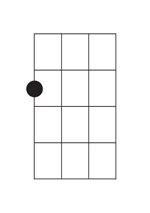 Use this song sheet to learn the ukulele chords to “Riptide” by Australian singer-songwriter Vance Joy. It’s easy for a beginner and you’ll also find lots of tips below to help bring life to the bizarre lyrics.
Use this song sheet to learn the ukulele chords to “Riptide” by Australian singer-songwriter Vance Joy. It’s easy for a beginner and you’ll also find lots of tips below to help bring life to the bizarre lyrics.
Why Does the Recording Sound Different than my Uke?
The recorded key is actually A#m. This means the above chords need to be A#m, G#, C#, and F# to match the pitch.
Option A – Easiest for GCEA
Since playing in A#m makes for hard chords, it’s a lot easier to simply use a capo on the first fret. (You could also tune up a half step to G#-C#-F-A# to achieve the same result.)
When you use a capo you can play the easy Am, G, C, and F chords you’re familiar with, but they will sound correct if you play with the recording.

Am

G

C

F
Option B – Vance’s Signature Down-Tuning
Even if you use a capo to match the pitch of the Riptide recording, the tone will still be off.
This is because instead of using a capo, Vance actually tunes down – WAY down. He drops all the strings down a major 3rd interval – or four frets – from standard GCEA.
His uke is tuned Eb-Ab-C-F (your tuner might also display it as: D#-G#-C-F).
What Are the Chords if I Tune Down?
If you choose to tune your ukulele like this, you have to use a different set of chord shapes to match the recording.
Vance uses baritone shapes to play the same-sounding chords on the de-tuned uke.

Am

G

C

F
What is the Strumming Pattern for Riptide?
The strumming pattern is: D D UDU.
That’s down, down, up, down, up (then repeat). The trick is to keep your hand moving down and up even when you aren’t strumming the uke!
If you keep the strumming hand “ghosting” over the strings during the times you don’t play, it’s much easier to keep your momentum and build a groove.
To do this, you need to change how you think of the pattern a bit. Your hand is now going to make the motion of: DUDUDUDU in the same space as the “real” strum, which, remember, is: D D UDU.
But you aren’t going to hit the strings for every strum otherwise it would sound wrong! Instead, you are going to (while continuing the non-stop down/up pattern) move your hand closer to your body when it’s time to sound the strings and further away from your body when it’s not.
If you superimpose the two on top of each other it looks like this:
The Strum: D D U D U The Motion: D U D U D U D U
Everywhere there is a gap in the original pattern you don’t strum – but your hand keeps moving! So all together the pattern will look like:
D(U)D(U)(D)UDU
On the strums in parenthesis you miss the strings as you go by.
My ear tells me that it’s likely that Vance used a thin flatpick (like these) to strum the rhythm part. Getting one might help you achieve the sound if you want to be super exact.
The Breakdown Riff Picking Tab
Here are two versions of the breakdown picking shown in tab:
(High-g tuning)
A |-----------------| E |------0-------0--| x4 C |--2h4-------0----| G |--------0--------|
*OR*
(Low-G tuning)
A |-----------------| E |------0-3-----0--| x4 C |--2h4-------0----| G |-----------------|
The first is for high-g tuning. This one sounds best to my ears since it utilizes the open G-string to create a ringing sound.
The second is for low-G tuning. This one isn’t as nice, but works in a pinch if you only have a low-G uke.
Adapting the Picking for Vance’s Down-Tuning
If you tune your uke to Eb-Ab-C-F, as shown in the section on tuning, you’ll have to play the picking differently. This is actually how Vance plays it – with a “high-g” (even though it’s tuned down).
F |------0-3-----0--| C |----5------------| x4 Ab |------------5----| Eb |--0--------------|
If you’re down tuning with a low-G, just move the open Eb-string note onto the 3rd fret of the C-string.
However, you can find an even nicer looking one from Ukulele Go by clicking on the button below.


